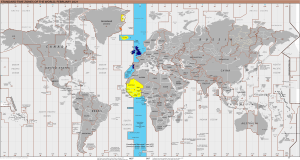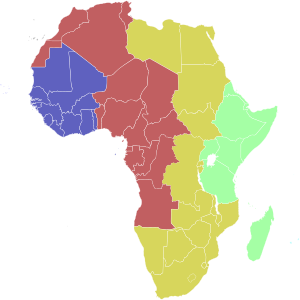UTC+00:00
Appearance
| UTC+00:00 | |
|---|---|
| Time zone | |
 World map with the time zone highlighted | |
| UTC offset | |
| UTC | UTC+00:00 |
| Current time | |
| 22:01, 8 October 2024 UTC+00:00 [refresh] | |
| Central meridian | |
| Date-time group | |


| Light Blue | Western European Time / Greenwich Mean Time (UTC) |
| Blue | Western European Time / Greenwich Mean Time (UTC) |
| Western European Summer Time / British Summer Time / Irish Standard Time (UTC+1) | |
| Red | Central European Time (UTC+1) |
| Central European Summer Time (UTC+2) | |
| Yellow | Eastern European Time / Kaliningrad Time (UTC+2) |
| Ochre | Eastern European Time (UTC+2) |
| Eastern European Summer Time (UTC+3) | |
| Green | Moscow Time / Turkey Time (UTC+3) |
| Turquoise | Armenia Time / Azerbaijan Time / Georgia Time / Samara Time (UTC+4) |
▉▉▉ Dark colours: Summer time observed

| Light Blue | Cape Verde Time[a] (UTC−1) |
| Blue | Greenwich Mean Time (UTC) |
| Red | (UTC+1) |
| Ochre | (UTC+2) |
| Green | East Africa Time (UTC+3) |
| Turquoise | (UTC+4) |
b Mauritius and the Seychelles are to the east and north-east of Madagascar respectively.
UTC±00:00 is the following time:
- Coordinated Universal Time (UTC), the basis for the world's civil time.
- Greenwich Mean Time[1]
- Western European Time[1]
- Azores Summer Time[1]
- Eastern Greenland Summer Time[1]
- Western Sahara Standard Time[1]
- Zulu Time Zone[1]
As winter time (Northern Hemisphere)
Principal cities: London, Dublin, Lisbon
Europe
 Ireland
Ireland Portugal (WET)
Portugal (WET) United Kingdom (GMT) (including Guernsey, Isle of Man and Jersey)
United Kingdom (GMT) (including Guernsey, Isle of Man and Jersey) Faroe Islands (WET)
Faroe Islands (WET)
Atlantic islands
Notes:
- The westernmost point where UTC with DST is applied is El Hierro, Canary Islands, Spain (18°00' W). Time used there is 2 hours and 12 minutes ahead of physical time in the summer, making for the greatest discrepancy in the UTC time zone.
- The easternmost settlement where UTC with DST is applied is Lowestoft in Suffolk, East Anglia, UK (at just 1°45' E).
- Note that Ireland[2] uses the term "standard time"[3] in reference to the summer months and "winter time" during what the rest of the time zone calls "standard time". This is the reverse of the practice of most countries in the EU, but provides the same end results.
As daylight saving time (Northern Hemisphere summer)
 Greenland
Greenland
- Ittoqqortoormiit and surrounding area
 Portugal
Portugal
- Azores islands
As standard time (all year round)
Principal cities: Accra, Bamako, Dakar
West Africa
 Burkina Faso
Burkina Faso Côte d'Ivoire
Côte d'Ivoire Gambia
Gambia Ghana
Ghana Guinea
Guinea Guinea-Bissau
Guinea-Bissau Liberia
Liberia Mali
Mali Mauritania
Mauritania Sahrawi Arab Democratic Republic (disputed territory)
Sahrawi Arab Democratic Republic (disputed territory) São Tomé and Príncipe
São Tomé and Príncipe Senegal
Senegal Sierra Leone
Sierra Leone Togo
Togo
Atlantic islands
 Greenland
Greenland
- Danmarkshavn and surrounding area
 Iceland
Iceland United Kingdom
United Kingdom
Antarctica
- Some bases in Antarctica. See also Time in Antarctica
Notes:
- The westernmost point where UTC with no DST is applied is Bjargtangar, at the northwest peninsula of Iceland (24°32' W). Time used there is 1 hour and 38 minutes ahead of physical time. This is the greatest deviation from physical time for UTC+00:00 with no DST.
References
- ^ a b c d e f "Western European Time". TimeAndDate.com.
- ^ Standard Time (Amendment) Act, 1971 – Schedule 1 Irish Statute Book
- ^ "STANDARD TIME ACT, 1968". Office of the Attorney General, Ireland. Retrieved 29 June 2012.
